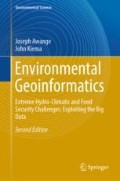Abstract
The most important function of GIS is the analysis of spatial data and their attributes for purposes of decision support. Indeed, spatial analysis is the very crux of GIS. It is the means of adding value to geographic data that allows the conversion of data into useful information and knowledge. As a data mining procedure, spatial analysis helps the GIS user to reveal inherent anomalies, patterns and relationships in GIS data sets that might not be otherwise apparent. This gives more insight into a place and helps in focusing and prioritizing actions or decisions. Strictly speaking, and at a higher level, one may distinguish between analysis and modeling as shown in Table 18.1. However, for purposes of the discussion here-under, the generic terminology analysis is used.
Everything is related to everything else, but near things are more related than distant things.
—First law of geography – Waldo Tobler
Access this chapter
Tax calculation will be finalised at checkout
Purchases are for personal use only
References
Longley PA, Goodchild MF, Maguire DJ, Rhind DW (2005) Geographic information systems and science. Wiley, West Sussex, England
Aronoff S (1989) Geographic information systems: a management perspective. WDL Publications, Ottawa, Canada
Burrough PA (1986) Principles of geographical information systems for land resources assessment. Oxford University Press, New York, p 50
Konecny G (2003) Geoinformation: remote sensing, photogrammetry. Taylor and Francis, Geographic Information Systems
Murai S (1999) GIS work book: fundamental and technical courses. Vols 1 & 2. National Space Development Agency, Japan
Tomlinson RF (2007) Thinking about GIS: geographic information system planning for managers. ESRI Press, New York, USA
Murai S (2004) Remote sensing and GIS courses—distance education. Japan International Cooperation Agency (JICA)-Net
Ministry of Education, Republic of Kenya (2011) Spatial analysis of school mapping data. Basic and Analytical Reports, Oakar services ltd
Galabawa JCJ, Agu AO, Miyazawa I (2002) The impact of school mapping in the development of education in Tanzania: an assessment of the experiences of six districts. Evaluation Program Planning 25(1):23–33
Mulaku GC, Nyadimo E (2011) GIS in education planning: the Kenyan school mapping project. Surv Rev 43(323):567–578
Chew LP (1989) Constrained delaunay triangulations. Algorithmica 4(1–4):97–108. https://doi.org/10.1007/BF01553881
Fortune S (1992) Voronoi diagrams and delaunay triangulations. World scientific publishing co, Computing in Euclidean geometry
Hjelle O, Daehlen, M (2006) Triangulations and applications. Springer, p 234. ISBN: 978-3-540-33260-2
Liu Y (2008) Computations of delaunay and higher order triangulations, with applications to Splines, Ph.D. Dissertation. University of North Carolina, Chappel Hill
Lahdelma R, Salminen P, Hokkanen J (2000) Using multicriteria methods in environmental planning and management. Environ Manage 26:595–605
Munier N (2004) Multicriteria environmental assessment. A practical guide. Kluwer Academic Publishers, Dordrecht, Netherlands
Annandale D, Lantzke R (2000) Making good decisions: a guide to using decision-aiding techniques in waste facility siting. Murdoch University, Perth, Australia, Institute for Environmental Science
Ministry of Environment and Energy, Government of Ontarion (1990) Evaluation methods in environmental assessment, pp 3–12, 33–51, 112–137
Malczewski J (2006) GIS-based multicriteria decision analysis: a survey of the literature. Int J Geogr Inf Sci 20(7):249–268
Kiema JBK, Dangana MA, Karanja FN (2007) GIS-based railway route selection for the proposed Kenya-Sudan railway: case study of Kitale-Kapenguria section. J Civil Eng Res Pract 4(1):79–90
Saxena SC, Arora S (1981) A text book of railway engineering. Dhanpat Rai and Sons, Delhi
Author information
Authors and Affiliations
Corresponding author
Rights and permissions
Copyright information
© 2019 Springer Nature Switzerland AG
About this chapter
Cite this chapter
Awange, J., Kiema, J. (2019). Spatial Analysis. In: Environmental Geoinformatics. Environmental Science and Engineering(). Springer, Cham. https://doi.org/10.1007/978-3-030-03017-9_18
Download citation
DOI: https://doi.org/10.1007/978-3-030-03017-9_18
Published:
Publisher Name: Springer, Cham
Print ISBN: 978-3-030-03016-2
Online ISBN: 978-3-030-03017-9
eBook Packages: Earth and Environmental ScienceEarth and Environmental Science (R0)

